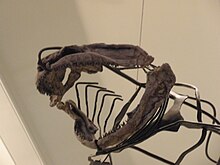Orthacanthus
Orthacanthus is an extinct genus of fresh-water xenacanthiform cartilaginous fish, named by Louis Agassiz in 1843,[3][4] ranging from the Upper Carboniferous[3] into the Lower Permian.
[3] During the Late Carboniferous-Early Permian, Orthacanthus was an apex predator of freshwater swamps and bayous in Europe and North America.
[7][4] Additionally, Orthacanthus can be diagnosed by major transverse axes of proximal ends at a 45-degree angle to and often almost parallel to the labial margin of the base between the cusps.
[8] The two genera Orthacanthus and Pleuracanthus were erected by Louis Agassiz based on isolated "ichthyodorulites" from the British Carboniferous System, and at the time were mistakenly thought of as the first indicators of skates.
[3] Teeth associated with Diplodus, a genus of sharks, was found in the Carboniferous slates of England in Stafford, Carluke, and Burdiehouse, and in Nova Scotia.
[7] Orthacanthus platypternus from the Craddock Bonebed shark layer in Texas, USA, shows evidence of resorption, and the equivalent of an "enamel pearl.
[10] The dorsal spines of Orthacanthus platypternus from the Craddock Bone Bed in Texas, USA, preserve a highly vascularized wall mainly composed of centrifugally growing dentine (the outer layer of the wall of the spine) in a succession of inwardly growing dentine layers that line the pulp cavity.
[12] Pucapampella Doliodus Cladodoides Tamiobatus Orthacanthus Cladoselache Cobelodus Akmonistion Kawichthys A 2013 analysis of oxygen and strontium isotope composition of the teeth and spines of Late Carboniferous and Early Permian shark taxa was performed to infer the hydrochemistry of their ambient water, thus contributing to the controversy between an obligate freshwater or euryhaline diadromous lifestyle.
[13] A study covering the morphology and histology of dorsal spines of Orthacanthus platypternus also reported that "The comparative analyses of the ontogenetic stages of the recorded specimens of O. platypternus and their distribution along different facies and localities indicate that this species was euryhaline, diadromous with a catadromous life-cycle which was strongly regulated by the semi-arid, seasonally dry tropical climate affecting western Pangea during the Early Permian.
[10]" The 2013 analysis provided evidence leaning towards an obligate freshwater lifestyle of the sharks from Variscan European basins, and nonmarine ratios suggested tooth formation was influenced by meteoric waves enriched by evaporation.
[14] Cranial remains of specimens of both Orthacanthus and Triodus from the Upper Carboniferous in Puertollano basin, Spain, give evidence of this predator-prey relationship.
[15][16] Orthacanthus had a diet that consisted of actinopterygians, acanthodians, dipnoans, xenacanthids and tetrapods, based on analysis of coprolites and gut contents.
[10] The oldest known specimen of Orthacanthus, Diplodus problematicus, was found in New Brunswick, Canada, in the Lower Devonian (Emsian, c. 407 to 393 million years ago).




